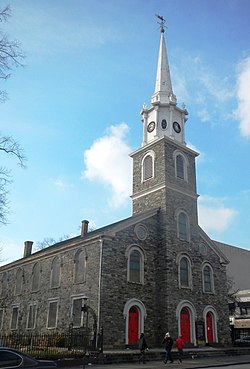| Flatbush Reformed Dutch Church Complex | |
| U.S. National Register of Historic Places | |
| New York City Landmark | |
 (2013) (2013) | |
   | |
| Location | 890 Flatbush Ave.Brooklyn, New York City |
|---|---|
| Coordinates | 40°39′0″N 73°57′33″W / 40.65000°N 73.95917°W / 40.65000; -73.95917 |
| Area | 2 acres (0.81 ha) |
| Built | Church: 1793-98 Parsonage: 1853 Church House: 1923-24 |
| Architect | Church: Thomas Fardon Church House: Meyer & Mathieu |
| Architectural style | Church: Federal Parsonage: Greek Revival / Italianate Church House: Colonial Revival |
| NRHP reference No. | 83001690 |
| Significant dates | |
| Added to NRHP | September 8, 1983 |
| Designated NYCL | May 15, 1966 January 9, 1979 (expansion) |
The Flatbush Reformed Protestant Dutch Church, also known as the Flatbush Reformed Church, is a historic Dutch Reformed church – now a member of the Reformed Church in America – at 890 Flatbush Avenue in the Flatbush neighborhood of Brooklyn, New York City. The church complex consists of the church, cemetery, parsonage and church house.
H.P. Lovecraft mentions the complex in passing in his story "The Horror at Red Hook", speaking of its "iron-railed yard of Netherlandish gravestones". The Church House and grounds are featured in season 2 of the Hulu TV series The Path, where they are used as the Meyerists' New York City headquarters.
History
The land on which the complex sits has been in continuous use for religious purposes longer than any other in New York City.
The congregation was founded in 1654 and the original church was built under the direction of Jan Gerritse Strijker at the order of Peter Stuyvesant. The 2.5-story stone Federal style church building designed by Thomas Fardon was constructed in 1793-98 and is the third church building on the site. It features a stone tower with stone belfry. The stained glass windows are by Tiffany studios and commemorate the descendants of many early settlers of Flatbush. The building was constructed of Manhattan schist, and the architecture includes Romanesque features such as arched windows and doors, as well as Tuscan colonettes. The church's bell was imported from Holland, and paid for by John Vanderbilt.
The bodies of American soldiers who died in the Battle of Long Island during the American War are reportedly buried underneath the church structure.
The cemetery is the last resting place for most of the founding families of Flatbush. The earliest legible grave marker dates to 1754. The 1853 parsonage is a 2.5-story wood-frame house designed in a vernacular style transitional between the Greek Revival and Italianate styles. It was moved to its present site at 2101-03 Kenmore Terrace in 1918. The church house is a 2.5-story red brick and limestone building designed by Meyers & Mathieu in the Colonial Revival style and erected in 1923–24.
The complex was initially designated a New York City Landmark in 1966, with the boundary expanded in 1979. It was listed on the National Register of Historic Places in 1983.
Gallery
-
 Church House
Church House
-
Cemetery
-
 Parsonage
Parsonage
-
 Undergoing repair work
Undergoing repair work
-
 Flatbush Reformed members participating in a parade circa 1969 within Brooklyn, New York City
Flatbush Reformed members participating in a parade circa 1969 within Brooklyn, New York City
See also
- Flatbush African Burial Ground
- List of New York City Landmarks
- National Register of Historic Places listings in Kings County, New York
References
Notes
- ^ "National Register Information System". National Register of Historic Places. National Park Service. March 13, 2009.
- ^ New York City Landmarks Preservation Commission; Dolkart, Andrew S.; Postal, Matthew A. (2009). Postal, Matthew A. (ed.). Guide to New York City Landmarks (4th ed.). New York: John Wiley & Sons. ISBN 978-0-470-28963-1. p.265
- "Flatbush Reformed Church". nycago.org. The NYC Chapter of the American Guild of Organists. Retrieved October 5, 2020.
- Rawson, Elizabeth Reich and Manbeck, John "Flatbush" in Jackson, Kenneth T., ed. (2010). The Encyclopedia of New York City (2nd ed.). New Haven: Yale University Press. ISBN 978-0-300-11465-2., pp.417-418
- ^ White, Norval; Willensky, Elliot; Leadon, Fran (2010). AIA Guide to New York City (5th ed.). New York: Oxford University Press. ISBN 978-0-19538-386-7. p.711
- "An historical sketch of the city of Brooklyn, and the surrounding neighborhood : including the village of Williamsburgh, and the towns of Bushwick, Flatbush, Flatlands, New Utrecht, and Gravesend : to which is added an interesting account of the battle of Long Island". archive.org. Retrieved 2015-12-06.
- "New York city guide; a comprehensive guide to the five boroughs of the metropolis: Manhattan, Brooklyn, the Bronx, Queens, and Richmond". archive.org. Retrieved 2015-12-06.
- Larry E. Gobrecht (June 1983). "National Register of Historic Places Registration:Flatbush Dutch Reformed Church Complex". New York State Office of Parks, Recreation and Historic Preservation. Archived from the original on 2012-10-19. Retrieved 2011-02-20. See also: "Accompanying 10 photos". Archived from the original on 2012-10-19.
External links
 Media related to Flatbush Reformed Dutch Church Complex at Wikimedia Commons
Media related to Flatbush Reformed Dutch Church Complex at Wikimedia Commons- Official Facebook page
| New York City historic sites | |
|---|---|
| National Register | |
| City Landmarks | |
| U.S. National Register of Historic Places in New York | ||
|---|---|---|
| Topics |   | |
| Lists by county |
| |
| Lists by city | ||
| Other lists |
| |
- Churches in Brooklyn
- Properties of religious function on the National Register of Historic Places in Brooklyn
- Federal architecture in New York City
- New York City Designated Landmarks in Brooklyn
- Cemeteries in Brooklyn
- Protestant Reformed cemeteries in the United States
- Reformed Church in America churches
- Former Dutch Reformed churches in New York (state)
- Flatbush, Brooklyn
- Dutch-American culture in New York City